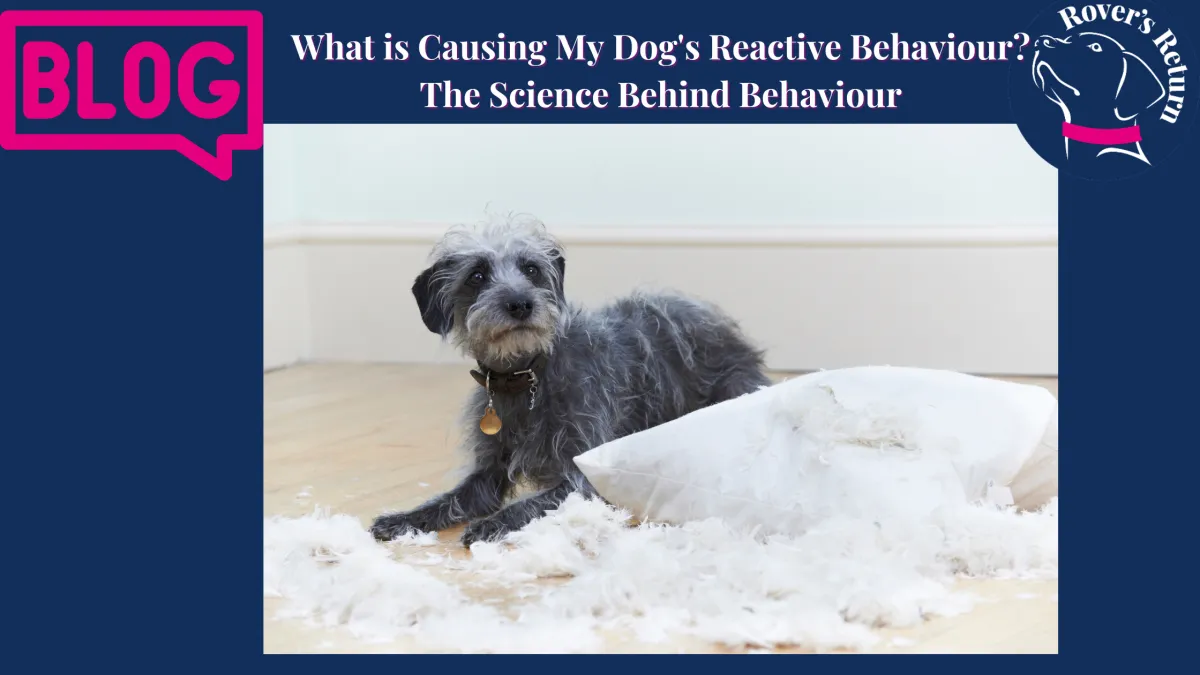
What is Causing My Dog's Reactive Behaviour? The Science Behind Behaviour

What is Causing My Dog's Reactive Behaviour?
The Science Behind Behaviour

All behaviour is an observable response that occurs due to a situation, event or stimulus.
It's essential to understand that many factors contribute to a dog’s behaviour. SOme of these factors are
Diet
Health
Early experiences
Breed
Breeder actions
Parents
Triggers
Training (and lack of)
Physiology
In this blog, we'll explore how behavioural problems manifest in dogs.
How Do Behavioural Problems Manifest in Dogs?
The survival instinct
All behaviour is to seek something to increase survival or avoid something potentially harmful.
Optimism is a happiness magnet.
An optimistic dog will live its life having more good things happen and they see fewer bad things happening. Optimistic dogs will take risks to gain access to benefits They can be happier when things do not go their way and will be more likely to try again, and not let bad things get them down.
Pessimism is essential for survival, there needs to be a level of caution toward the unknown, problems can occur when dogs are overly pessimistic Pessimism is a state of mind where they believe things will go wrong, they expect the worse and challenges will be difficult to overcome.
This perspective can influence how the dog interprets events, makes decisions, and interacts with the world and behaves.
The Brain and Behaviour
Once the dog’s brain perceives fear, anxiety and worry the brain drives a reflex behavioural response.
The part of the brain responsible for responding to sensory information is the reticular activating system (RAS).
What are the 4 functions of the reticular activating system?
The four functions of the RAS are
Sensation,
Consciousness
Attention
Sleep-wake cycle
For the blog, we will look at sensory information and how it affects behaviour.
What key roles does the reticular formation have in regulating Behaviour?
Filtering Sensory Input
The RAS is responsible for filtering incoming sensory information and deciding what will enter our conscious awareness. Without it, we would not be able to cope with all the information around us, it would be too much to cope with.
For instance, in a crowded room filled with noise, you can still focus on a conversation with a friend because the RAS helps prioritise the auditory input while filtering out irrelevant background noise. This filtering process ensures that we aren't overwhelmed by all the stimuli around us.
In terms of behaviour, this filtering mechanism influences what we pay attention to and how we perceive the world. If your dog is constantly thinking about a specific issue—such as if another dog is a threat, or the noise is something that is going to harm them, in situations where quick, reflexive action is needed, the RAS influences how your dog reacts to external events, particularly by prioritising stimuli that are perceived as important, urgent, or potentially threatening.
When the dog perceives a threat the RAS triggers a physiological response to keep the dog safe. The behaviour that you see is a direct response to the perception of the threat.
Heightened Sensitivity to Threats
One of the key functions of the RAS is to maintain alertness and arousal, increasing stress levels.
The RAS filters incoming sensory information and prioritises stimuli that signal a potential threat to survival. This activation is part of the fight-or-flight response, where the RAS plays a role in raising the level of arousal to deal with the perceived threat. heart rate increases, adrenaline is released, and muscles tense, all in preparation for immediate action.
This reactive behaviour is automatic, as the RAS helps ensure you're ready to respond to potential danger before you've even had time to consciously think about it.
A highly pessimistic dog's RAS will be on alert, expecting a threat and driving a reflex physiological response.
Emotions And Reactivity
The RAS interacts with the limbic system, particularly the amygdala, which governs emotional responses, such as fear, anger, or excitement. When the RAS detects stimuli that may have an emotional impact—such as a stressful confrontation or an alarming event—it quickly passes this information to the emotional centres of the brain.
When you hear about people talking about acting without thinking, it is the amygdala, that bypasses the neocortex to act.
How Does The Reticular Activating System Affect Behaviour?
The reticular activating system plays a critical role in shaping reactive behaviour by filtering sensory input, prioritising attention, and triggering emotional and physical responses
Reactive behaviours become habitual over time, especially when certain stimuli repeatedly trigger similar responses. This is why walking your dog daily can increase reactivity for dogs who struggle in the presence of other dogs. The repeated exposure leads to an overactive RAS
The RAS shapes behavioural patterns. It recognises recurring stimuli and may condition the brain to react in certain ways. If previous encounters lead to discomfort, or becoming hyper-alert in settings that have previously been stressful.
Over time, these reactive behaviours can become ingrained, leading to automatic responses in similar situations.
How To Calm The Reticular Activating System?
Implementing reward-based training, using desensitisation and counter-conditioning is one of the key areas to work on.
Reducing your dog's reactions by changing their environment and not exposing them to triggers whilst working on an effective behaviour modification plan designed by a qualified, force-free behaviourist will change future responses.
It is important to understand that these things take time! By understanding how the RAS influences behaviour, you can become more aware of your responses and work toward developing more deliberate, thoughtful actions in place of automatic, reflexive reactions. This awareness can help you manage stress, improve emotional regulation, and develop healthier behavioural patterns.
